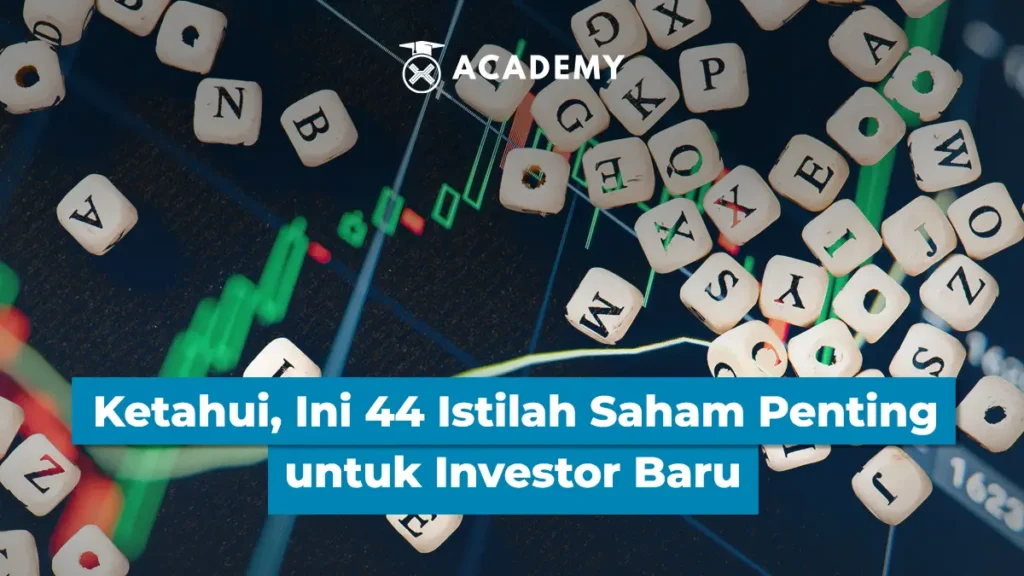Stocks are proof of ownership of a company that entitles them to dividends and assets. In the capital market, stocks are traded on the stock exchange, with prices fluctuating depending on the company’s performance and market conditions.
Investors who buy stocks become part of the company’s owners and have the potential to profit from price increases or dividends.
Basically, understanding stock terms helps investors make better decisions. Concepts such as dividends, capital gains, P/E ratios, and volatility are important in assessing investment opportunities and risks.
With good insight, investors can read financial reports, understand company strategies, and follow market trends that affect their investments.
44 Stock Terms You Must Understand

Understanding the terms in the stock market is very important for investors, especially for beginners. Here are 44 stock terms that must be understood to be better prepared to face the dynamics of the capital market:
1. Acquisition
Acquisition refers to the process by which a company takes over ownership of another company by purchasing a majority of its shares.
Through this process, the acquiring company gains control over the operations and business decisions of the acquired company.
2. Annual Report
An annual report is an official document that contains a comprehensive overview of the company’s business activities over the past year.
This report covers financial aspects, company achievements, and planned business strategies for the future.
People Also Read: What is ARA Stock? Its Meaning and Function at the IDX
3. ARA (Auto Rejection Up)
ARA is a mechanism on the stock exchange that sets a maximum limit for stock price increases in a day.
If the stock price reaches the specified upper limit, further buying and selling transactions will be automatically delayed and cannot be processed on that day.
4. ARB (Auto Rejection Down)
ARB is the opposite of ARA, which is the maximum limit for stock price decreases in one day.
If the stock price falls to the lower limit determined by the exchange, the stock buying and selling transactions will automatically be stopped to prevent further declines.
5. Average Down
Average down is an investment strategy carried out by buying back shares when the price falls.
The purpose of this strategy is to obtain a lower average share purchase price so that when the stock price rises again, the potential profit becomes greater.
6. Average Up
Average up is an investment strategy carried out by buying shares gradually at a higher price than the previous purchase.
Investors use this strategy when they are confident that the stock is in an upward trend and has the potential to continue to strengthen.
7. Bandar
In the world of stocks, the term bandar refers to a party that has large capital and is able to influence the movement of stock prices in the capital market.
Usually, this term refers to institutions such as investment managers or securities companies, although in some cases it can also refer to individual investors with large capital.
People Also Read This: Stock Bandar: Main Mover or Market Manipulator?
8. Bearish
Bearish is a condition in which the stock market experiences a continuous downward trend in prices. This situation is often associated with negative investor sentiment, economic slowdown, or other external factors that affect the market.
9. Bullish
Bullish is the opposite of bearish, where the stock market shows a continuous upward trend in prices.
This condition usually occurs when investor confidence is high, supported by positive economic factors or optimism about the prospects of a particular company.
10. Breakout
Breakout is a term in technical analysis that describes a condition when a stock price manages to break through a support or resistance area.
This event is often considered a strong signal to buy or sell shares, depending on the direction of price movement after the breakout occurs.
11. Buyback
Buyback refers to the process by which a company buys back its shares that have previously been circulated in the market.
This step is usually taken to reduce the number of shares outstanding, increase the value of the remaining shares, or as a long-term investment strategy for the company.
12. Capital Gain
Capital gain is the profit obtained by investors from the difference between the selling price and the purchase price of shares. This profit occurs when shares are sold at a higher price than when they were purchased.
13. Capital Loss
Capital loss is a condition in which investors experience losses because they sell shares at a lower price than the initial purchase price.
14. Cut Loss
Cut loss is a strategy to limit losses by selling shares whose value continues to fall before the loss becomes greater.
This technique is often used to protect capital and avoid the adverse effects of a deeper price decline.
15. Price Fraction
Price fraction refers to the minimum change in the price of shares traded on the exchange.
On the Indonesia Stock Exchange (IDX), there are five groups of price fractions that determine the smallest increase or decrease that can occur in a stock.
16. Dividends
Dividends are a portion of a company’s profits that are distributed to shareholders in accordance with company policy. Dividend distribution is usually done once or twice a year in the form of cash or additional shares.
People Also Read: These are the 5 American Stocks with the Largest Dividends, Must Check!
17. Dividend Yield
Dividend Yield measures the level of return on investment obtained by shareholders from dividends distributed by the company in a year.
The calculation of this ratio is done by dividing the annual dividend per share by the current stock price, which is then expressed as a percentage.
18. Dividend Payout Ratio
The Dividend Payout Ratio is an indicator that shows the percentage of a company’s net profit allocated to dividend payments to shareholders.
This ratio is calculated by comparing the total dividends paid with the company’s total net profit in one period.
19. EPS (Earnings Per Share)
EPS or earnings per share is a financial ratio that describes the profit earned by a company for each outstanding share.
EPS is calculated by dividing the company’s net income by the total number of outstanding shares, and the result is often used to measure the company’s profitability.
20. Swing Trading
Swing trading is a short-term stock trading strategy with the aim of making a profit in a matter of days to weeks.
The perpetrators of this strategy are called swing traders, who take advantage of stock price fluctuations to achieve optimal profit.
21. Issuer
Issuer is a term used to refer to companies that have listed their shares on the Indonesia Stock Exchange (IDX) and traded them to the public.
22. Fried Stocks
Fried stocks refer to stocks with weak fundamentals whose prices are easily manipulated by certain parties due to their small market capitalization. This type of stock has high volatility and is risky for novice investors.
People Also Read: Fried Stocks: What Are They and How to Avoid Them?
23. Go Public
Going public is the process by which a company offers shares or other securities to the public through the stock exchange. By going public, companies can obtain funds from public investors for their business development.
24. Growth Stock
Growth stock refers to stocks of companies with higher growth potential than the industry average.
Stocks in this category often attract investors’ attention because of their promising profit prospects, although they are usually priced higher than their fair value.
25. Window Dressing
Window dressing is a phenomenon where the shares of large companies with high market capitalization (blue chips) tend to experience price increases towards the end of the year.
This phenomenon is often associated with the strategy of investment managers to beautify their portfolios before the fiscal year ends.
26. IHSG (Composite Stock Price Index)
IHSG is an index that reflects the price movements of all shares listed on the Main Board and Development Board of the Indonesia Stock Exchange (IDX).
This index is used as the main indicator to see the overall stock market trend in Indonesia.
27. IPO (Initial Public Offering)
IPO is the process when a company first offers its shares to the public through the stock exchange.
By conducting an IPO, the company can raise funds from investors and become a public company whose shares are freely traded on the capital market.
28. JATS (Jakarta Automated Trading System)
JATS is a computer-based stock trading system used on the Indonesia Stock Exchange to ensure that stock buying and selling transactions run automatically and efficiently.
The system allows investors to trade stocks in real-time with more transparency.
People Also Read: What is JATS? BEI’s Advanced System You Need to Know
29. Market Capitalization
Market capitalization or market cap is the total market value of a company whose shares are traded on the stock exchange.
This value is calculated by multiplying the current stock price by the number of shares outstanding in the market. Market capitalization is often used to measure the size and value of a company.
30. Custodian
A custodian is a financial institution tasked with storing, securing, and managing investors’ investment assets in the capital market. With a custodian, risks such as loss, misuse, or theft of assets can be minimized.
31. Listing and Delisting
Listing is the process of recording a company’s shares on the stock exchange so that they can be traded by investors. Conversely, delisting occurs when a company’s shares are removed from the exchange so that they can no longer be traded on the capital market.
32. Lot
A lot is a standard unit in stock trading in Indonesia, where one lot consists of 100 shares. Investors must buy or sell shares in multiples of lots when transacting on the exchange.
33. Investment Manager
An investment manager is a party responsible for managing a portfolio of securities or collective investment funds, such as mutual funds, with the aim of generating profits for investors.
This role includes market analysis, investment strategies, and selecting the best assets according to the investor’s risk profile.
34. Securities Company
A securities company is a financial institution that has received permission from the Financial Services Authority (OJK) to operate in the capital market.
This company provides various services, such as being a stockbroker, underwriter, and other activities related to the capital market.
35. GMS (General Meeting of Shareholders)
A GMS is an official forum held by a public company to meet with shareholders.
In this meeting, shareholders have the opportunity to vote and discuss important decisions related to company policies, financial reports, dividend distribution, and management changes.
People Also Read: What is a Stock GMS? An Important Guide for Shareholders
36. Blue Chip Stocks
Blue chip stocks refer to stocks from companies that have solid business fundamentals, stable financial performance, large market capitalization, and a track record of distributing dividends regularly.
Issuers in this category are usually industry leaders or have a large influence in their business sector. Blue chip stocks are also known as first-tier stocks because of their superior quality compared to other types of stocks.
37. Middle Cap Stocks
Middle cap stocks or second-tier stocks are stocks from companies that have medium market capitalization. Although its performance is quite good and its liquidity is higher than small stocks, its market capitalization is still below blue chip stocks.
In addition, the price of middle cap stocks is generally more affordable than first-tier stocks, so it is often the choice of investors looking for growth opportunities.
38. Small Cap Stocks
Small cap stocks or third-tier stocks are stocks from companies with low market capitalization. Because the number of shares in circulation is relatively small, the price of these stocks is more susceptible to significant changes due to speculative actions.
Stocks in this category are often referred to as gorengan stocks because their price movements are very volatile and often do not reflect the company’s fundamental value.
39. Stock Split
A stock split is a corporate action taken by dividing the stock price in a certain ratio so that the number of shares in circulation increases while the total investment value remains the same.
This step is usually taken when the stock price is too high to make it more affordable for investors. With a stock split, stock liquidity in the market can increase because more investors are able to buy it.
40. Suspend
Suspend or suspension is a temporary suspension of trading of a stock on the stock exchange.
This can happen for various reasons, such as violations of regulations by the issuer, stock price movements that are considered unreasonable, or requests from the company concerned.
Suspension is carried out to maintain market stability and protect investors from potential greater risks.
People Also Read: Stock Suspension Is a Step to Protect Investors!
41. Stock Exchange
A stock exchange is an institution that provides a trading system to bring together parties who want to buy and sell securities such as stocks and bonds.
Some examples of famous stock exchanges in the world include the Indonesia Stock Exchange (IDX), NASDAQ, New York Stock Exchange (NYSE), Singapore Exchange (SGX), and London Stock Exchange (LSE).
42. Go Private
Going private occurs when a company that has previously gone public decides to return to being a private company.
This process is carried out by buying back all shares circulating in the public, so that the company is no longer listed on the stock exchange.
43. HAKA (Hajar Kanan)
HAKA is a term in the stock world which means buying shares at the highest price in the offer so that transactions can be executed immediately without having to wait in line.
44. HAKI (Hajar Kiri)
HAKI refers to the act of selling shares at the lowest bid price so that the shares are sold immediately without waiting for a queue of buyers.
How to Choose the Right Stocks Based on These Terms
Choosing the right stocks requires an understanding of various terms in the investment world. Here are some ways that can be used in choosing stocks based on terms that are often used in the capital market:
1. Assessing Stock Potential
- P/E Ratio: Used to assess whether the stock price is fair compared to the company’s profit. The lower this ratio, the cheaper the stock price is compared to its profit.
- Dividend Yield: Measures the percentage of profit that investors get from dividends compared to the stock price. Suitable for investors looking for passive income.
- Growth Stock: Stocks of companies with above-average growth potential, usually have rapid stock price increases even though the dividends paid are smaller or even non-existent.
2. Strategy Based on Term Analysis
- Average Down: Strategy to buy additional shares when the price drops to get a lower average price, with the hope that the stock price will rise again.
- Swing Trading: Strategy to buy and sell shares in the short term to take advantage of price fluctuations in daily or weekly periods.
- Cut Loss: Steps to sell shares that are falling in order to limit losses so that they do not get bigger.
Common Mistakes Beginner Investors Should Avoid

Investing in the stock market requires a good strategy and understanding so as not to get caught in a detrimental decision. Below are some mistakes that novice investors often make and how to avoid them:
1. Panic Selling
Selling stocks emotionally when prices drop drastically without careful analysis can make investors miss the opportunity for price recovery. It is better to stay calm and evaluate before making a decision.
2. Investing in Fried Stocks
Stocks that have weak fundamentals with unreasonable price movements tend to be high risk. Avoid being tempted by instant profits and focus on stocks with more stable performance.
3. Lack of Diversification
Allocating all capital to only one stock or sector increases the risk of loss. Diversifying a portfolio with various stocks from different industries can help reduce risk and increase profit opportunities.
Conclusion
So, that was an interesting discussion about 44 Important Stock Terms for New Investors that you can read in full at the Crypto Academy at INDODAX Academy. and not only increase your insight into investment, here you can also find the latest crypto news about the crypto world
In conclusion, understanding various terms in the stock market is not only about increasing insight, but also the key to making smarter investment decisions.
By understanding concepts such as stock valuation, trading strategies, and potential risks, investors can avoid common mistakes that often occur, such as panic selling or getting caught up in fried stocks.
The stock market offers great profit opportunities, but also has risks that need to be managed properly. Therefore, patience, thorough analysis, and the right strategy will help investors achieve more optimal investment results.
As additional information, INDODAX will soon present a new feature that allows users to invest in stocks traded on the United States stock exchange.
With this feature, users can access more than 50 stocks from the US market, expanding their investment portfolio beyond crypto assets in the same account on the INDODAX platform.
FAQ
1.What are stocks and why is it important to invest in stocks?
Basic explanation of stocks and their benefits as a long-term investment instrument.
2.How to use the P/E Ratio in choosing stocks?
Explanation of how to read the P/E ratio to assess stock valuation.
3.What is meant by gorengan stocks and why are they dangerous?
Why are these stocks risky and how to recognize their characteristics.
4.What should be done if the stock price falls?
Tips for managing risk and implementing strategies such as Cut Loss or Average Down.
5.How to follow an IPO?
A step-by-step guide to following the IPO of companies listed on the Indonesia Stock Exchange.





 Polkadot 10.32%
Polkadot 10.32%
 BNB 6.84%
BNB 6.84%
 Solana 4.95%
Solana 4.95%
 Ethereum 2.43%
Ethereum 2.43%
 Cardano 1.62%
Cardano 1.62%
 Polygon Ecosystem Token 2.17%
Polygon Ecosystem Token 2.17%
 Tron 2.81%
Tron 2.81%
 Market
Market


